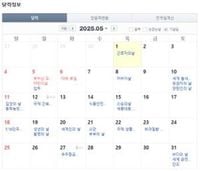As May approaches, anticipation is building around whether May 2, 2025, will be designated as a temporary holiday in South Korea. This year, Children’s Day on May 5 coincides with Buddha’s Birthday, creating a potential Golden Holiday from Saturday, May 3, through to the substitute holiday on May 6. If May 2, which falls on a Friday, is officially recognized as a temporary holiday, it would allow citizens to enjoy a continuous six-day break.
The interest in this potential holiday designation has sparked discussions among the public. Many citizens are hopeful for an official announcement that would extend the holiday, especially after the government previously designated a temporary holiday during the Lunar New Year to stimulate domestic demand. However, there is also a growing sense of dissatisfaction and concern regarding the lack of clarity from the government.
As it stands, the government has confirmed that June 3, 2025, the date of the presidential election, will be a public holiday. Yet, no official discussions have taken place regarding May 2. With Labor Day on May 1, followed by the weekend and subsequent holidays, the potential for a six-day continuous break has many people eagerly awaiting news.
One lawyer commented, "Temporary holidays are a matter of government decision, and at least a week before, they must be announced. At the latest, it should be announced on April 30, 2025, so that people can make plans." This sentiment resonates with many who feel that a timely announcement is essential for effective holiday planning.
However, not everyone is supportive of the idea of May 2 being a temporary holiday. Online communities have seen a mix of reactions, with some expressing frustration over the lack of clear communication. Comments such as, "If you're going to notify us before the vacation, don't play around," and "All school schedules and work schedules are messed up," reflect the concerns of those who feel that such last-minute decisions could disrupt their plans.
Moreover, there are worries that the designation of a temporary holiday might not have the desired effect of boosting domestic tourism. During the previous Lunar New Year holiday, despite the government's intentions, travel demand shifted significantly toward overseas destinations. The number of outbound travelers during the month that included the temporary holiday increased by 7.3% compared to the previous year, and during the October temporary holiday season, the increase was even more pronounced at 16.6%.
With the cherry blossom season in Japan coinciding with the May holidays, there are fears that even more South Koreans may choose to travel abroad rather than participate in domestic tourism. This could lead to a host of issues, including overcrowding in popular tourist areas, rising airfare prices, and a decrease in domestic consumption.
The government’s decision-making process regarding the holiday designation involves consultations with various stakeholders, including the ruling party and the Ministry of Economy and Finance. The Ministry of Personnel Management will then present the agenda to the State Council for final approval. Given the complexities involved, the prospect of extending the holiday remains uncertain.
As the clock ticks down to the end of April, many citizens are left wondering if they will be able to enjoy a longer break this May. The anticipation surrounding the potential temporary holiday reflects broader hopes for relaxation and leisure time amidst the pressures of daily life. Whether the government will respond to these hopes with a timely announcement remains to be seen.
In summary, the potential designation of May 2, 2025, as a temporary holiday has sparked significant interest and debate among South Koreans. While many are hopeful for an extended break, the government’s lack of official communication has led to frustration and uncertainty. As the May holidays approach, the decision will likely impact not only travel plans but also the broader economic landscape in the country.






